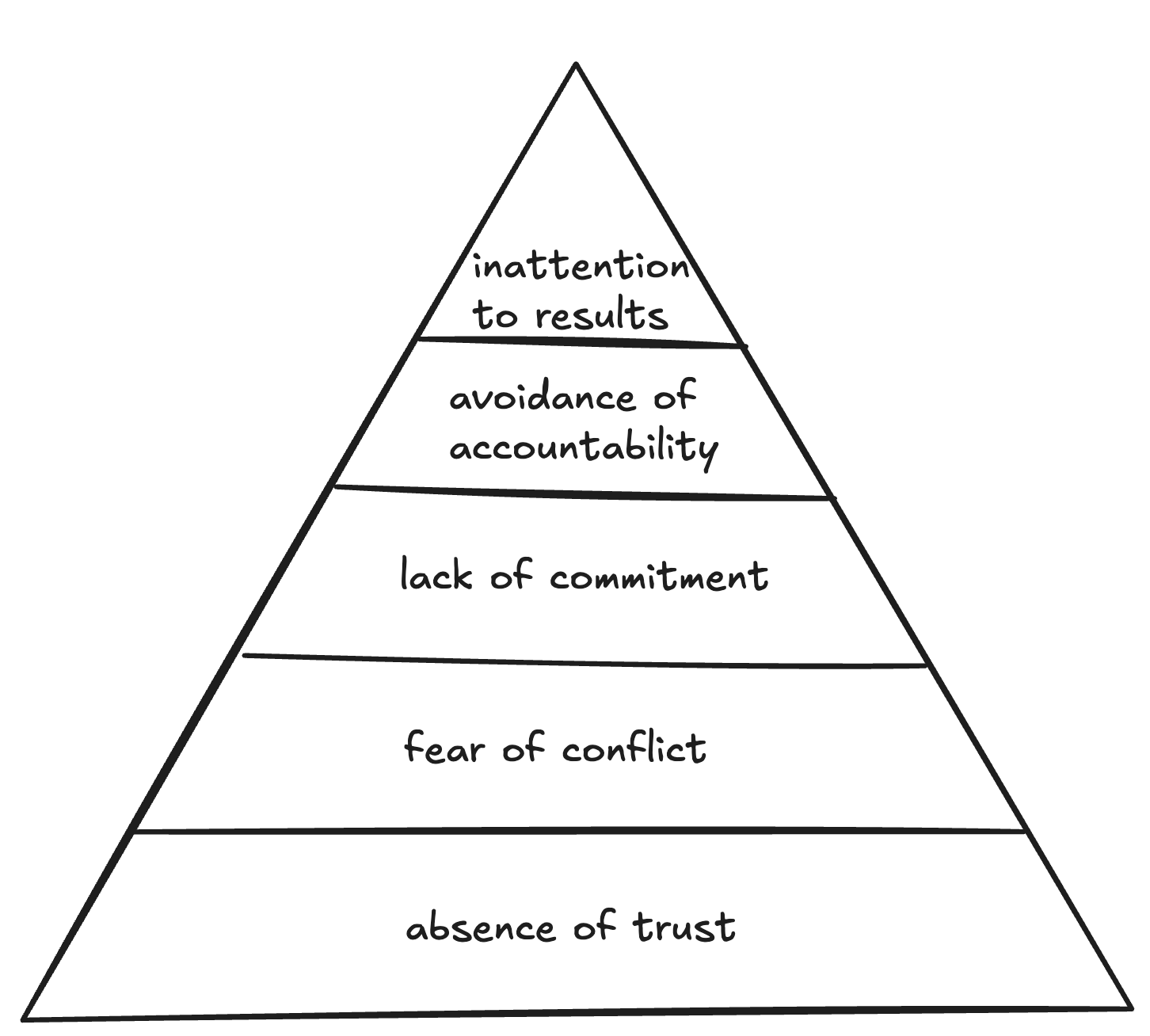The Five Dysfunctions of a Team

A fractured team is just like a broken arm or leg; fixing it is always painful, and sometimes you have to rebreak it to make it heal right. And the rebreak hurts a lot more than the initial break, because you have to do it on purpose.
5 reasons why teams are dysfunctional
Absence of trust
- What is it?
- Trust is the foundation of real teamwork
- The vulnerabilities include weaknesses, skill deficiencies, interpersonal shortcomings, mistakes, and requests for help.
- Great teams admit all of them without fear of punishment
- Tools to overcome
- Personal histories exercise. Team members go through a short list of questions about themselves (e.g. hometown, favorite hobbies, first job, worst job)
- Team effectiveness exercise. Requires team members to identify the single most important contribution that each of their peers makes to the team and one area that person must improve or eliminate for the good of the team.
- Personality and Behavioral Preference Profiles. The suggested profiling tool - MBTI (Myers Briggs Type Indicator). The purpose is to provide practical and scientifically valid behavioral descriptions of various team members according to the diverse ways they think, speak and act.
- 360-degree feedback. It’s a popular tool where each team members provide a feedback about their peers. It’s recommended to divorce the tool from compensation or performance evaluation and use it as a development tool.
- Experimental Team Exercises. Outdoor activities can be a good example but not always those exercises are translated directly to the working world.
Fear of conflict
- What is it?
- Teams without trust can’t have honest and open debates.
- Teams that engage in productive conflict know that the only purpose is to produce the best possible solution in the shortest period of time.
- Tools to overcome
- The first step is to acknowledge that conflict is productive and that many teams have a tendency to avoid it.
- Mining. Members that tend to avoid conflict must occasionally assume role of a “miner of conflict” - someone who extracts buried disagreements within the team and force team members to work through them.
- Real-time permission. Recognize when people become uncomfortable and remind them that it’s necessary
Lack of commitment
- What is it?
- If team members don’t share their opinions openly, they’re unlikely to fully support or commit to decisions.
- Tools to overcome
- Cascading messaging. A team should explicitly review the key decisions made during the meeting and agree on what has to be communicated to their employees.
- Deadlines. As simple as it seems, it’s one of the best tools for ensuring commitment.
- Contingency and Worst-Case Scenario Analysis. Discussing contingency plan up front or clarifying the worst-case scenario for a decision the team is struggling to make.
- Low-risk Exposure Therapy. When team forces themselves to make decisions after substantial discussion but little research, they usually come to realize that the quality of the decision they made was better then they had expected.
Avoidance of accountability
- What is it?
- When there’s no clear plan, people often avoid calling out teammates for actions or behavior that hurt the team.
- Tools to overcome
- Publication of goals and standards. Clarify publicly exactly what the team needs to achieve, who needs to deliver what and how everyone must behave
- Simple and regular progress reviews.
- Team rewards. Shift rewards away from individual performance to team achievement
Inattention to results
- What is it?
- It occurs when team members put their individual needs above the collective goals of the team
- If the team loses, everyone loses
- Tools to overcome
- Public declaration of results. Team that are wiling to commit publicly to specific results are. ore likely to work with a passionate desire to achieve those results.
- Results-based rewards. To ensure that team members focus on results is to tie their rewards, especially compensation, to the achievement of specific outcomes.

Another way to understand the model is to take the opposite approach - a positive one
- Team members trust each other
- They engage in unfiltered conflict around ideas
- They commit to decisions and plans of action
- They hold one another accountable for delivering against those plans
- They focus on achievement of collective results